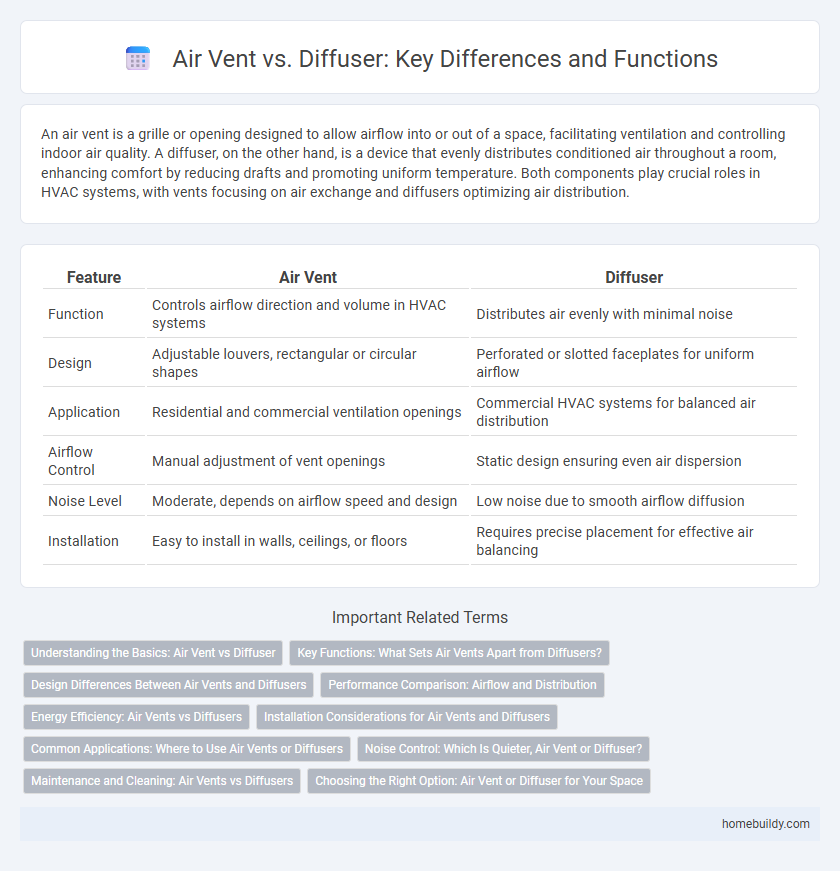An air vent is a grille or opening designed to allow airflow into or out of a space, facilitating ventilation and controlling indoor air quality. A diffuser, on the other hand, is a device that evenly distributes conditioned air throughout a room, enhancing comfort by reducing drafts and promoting uniform temperature. Both components play crucial roles in HVAC systems, with vents focusing on air exchange and diffusers optimizing air distribution.
Table of Comparison
| Feature | Air Vent | Diffuser |
|---|---|---|
| Function | Controls airflow direction and volume in HVAC systems | Distributes air evenly with minimal noise |
| Design | Adjustable louvers, rectangular or circular shapes | Perforated or slotted faceplates for uniform airflow |
| Application | Residential and commercial ventilation openings | Commercial HVAC systems for balanced air distribution |
| Airflow Control | Manual adjustment of vent openings | Static design ensuring even air dispersion |
| Noise Level | Moderate, depends on airflow speed and design | Low noise due to smooth airflow diffusion |
| Installation | Easy to install in walls, ceilings, or floors | Requires precise placement for effective air balancing |
Understanding the Basics: Air Vent vs Diffuser
Air vents primarily serve as entry and exit points for airflow within HVAC systems, facilitating air distribution and ventilation in a space. Diffusers, designed to disperse and regulate airflow more evenly, enhance comfort by controlling air velocity and direction. Understanding the fundamental differences helps in selecting the right component to ensure efficient air circulation and optimal indoor air quality.
Key Functions: What Sets Air Vents Apart from Diffusers?
Air vents primarily regulate airflow by allowing fresh air to enter or stale air to exit a space, focusing on ventilation and air exchange. Diffusers distribute conditioned air evenly throughout a room, enhancing comfort by controlling air direction and flow patterns. Air vents differ by emphasizing airflow control and exchange, while diffusers prioritize uniform air distribution and minimizing drafts.
Design Differences Between Air Vents and Diffusers
Air vents typically feature simple, adjustable louvers that direct airflow in specific directions, emphasizing functionality and ease of use. Diffusers, however, incorporate a more complex design with multiple fins or perforated faces to evenly distribute air, reducing drafts and enhancing room comfort. The design differences highlight vents' primary role in airflow control versus diffusers' focus on aesthetic integration and uniform air dispersion.
Performance Comparison: Airflow and Distribution
Air vents and diffusers differ significantly in airflow performance and distribution efficacy; air vents typically provide direct, high-velocity airflow with limited spread, making them ideal for targeted ventilation. Diffusers excel in evenly distributing conditioned air across larger spaces, reducing drafts and enhancing occupant comfort by dispersing air gently. Selecting between air vents and diffusers impacts HVAC system efficiency and indoor air quality, depending on specific airflow patterns and distribution needs.
Energy Efficiency: Air Vents vs Diffusers
Air vents and diffusers differ significantly in energy efficiency, with diffusers providing more controlled airflow distribution that reduces HVAC system workload and enhances thermal comfort. Air vents often allow larger, less regulated air volume, leading to higher energy consumption due to uneven temperature control and increased demand on heating or cooling units. Selecting energy-efficient diffusers optimizes indoor air quality while minimizing energy costs by maintaining balanced air pressure and reducing system strain.
Installation Considerations for Air Vents and Diffusers
Air vent installation requires precise alignment with HVAC ductwork to ensure optimal airflow and pressure balance, often necessitating secure framing within ceilings or walls. Diffuser installation focuses on distributing conditioned air evenly across a room, typically involving adjustable features for airflow direction and volume control. Both require careful sealing to prevent air leakage and compatibility checks with existing ventilation systems to maximize efficiency.
Common Applications: Where to Use Air Vents or Diffusers
Air vents are typically used in residential and commercial buildings to allow fresh air intake or stale air exhaust, ensuring proper ventilation in spaces like bathrooms, kitchens, and utility rooms. Diffusers are commonly installed in HVAC systems to distribute conditioned air evenly throughout larger areas such as offices, conference rooms, and open-plan spaces, enhancing airflow and comfort. Choosing between air vents and diffusers depends on the specific application's airflow requirements, space size, and the desired air distribution pattern.
Noise Control: Which Is Quieter, Air Vent or Diffuser?
Air diffusers generally produce less noise compared to air vents due to their design, which evenly distributes airflow and reduces turbulence. Air vents often create more sound because of direct air discharge and higher velocity, resulting in louder operational noise. Choosing a diffuser is preferable for quieter environments, especially in offices and residential spaces where noise control is critical.
Maintenance and Cleaning: Air Vents vs Diffusers
Air vents typically require less frequent cleaning than diffusers due to their simpler design and fewer moving parts, making maintenance straightforward. Diffusers, with adjustable blades or intricate designs, can accumulate dust and debris more easily, necessitating regular cleaning to maintain airflow efficiency. Proper maintenance of both components ensures optimal indoor air quality and system performance, but diffusers demand more attention for effective cleaning.
Choosing the Right Option: Air Vent or Diffuser for Your Space
Choosing between an air vent and a diffuser depends on your space's airflow needs and aesthetic preferences. Air vents typically provide direct, high-velocity airflow suitable for ventilation and quick temperature regulation, while diffusers distribute air more evenly and quietly, enhancing comfort in living and office environments. Consider factors like room size, ceiling height, and noise sensitivity to select the option that optimizes air distribution and energy efficiency.
Air vent vs Diffuser Infographic

 homebuildy.com
homebuildy.com